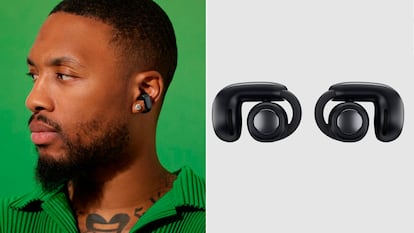The next generation of headphones are worn outside the ear
Companies like Bose and Huawei now offer open-design earbuds that offer better awareness of your surroundings

Many people don’t like wearing earbuds. Their ears hurt or they don’t like how soft earbuds make them feel like they’re floating in a vacuum. If this is you, perhaps you’ll want to explore all the options for listening to music privately while walking, working or traveling.
The Ultra Open Earbuds, recently introduced by audio company Bose, feature an open design. They hook onto the bottom of the ear, offering awareness of your surroundings and the convenience of automatic volume adjustment. You will no longer have to turn the volume down to have a conversation or listen to an announcement.
Private listening
These open-design headphones are not yet widely available, and most are of questionable quality from lesser-known brands. But they are super comfy — you might even forget you have them on. The Bose Ultra Open Earbuds do have outstanding audio quality, although phone calls tend to sound slightly distorted. Despite the open design, the sound is surprisingly well contained; only the wearer can hear it.
For the Ultra Open Earbuds, Bose used technology similar to that of their Bose Frames connected eyeglasses, a now-discontinued product offered with corrective lenses or as sunglasses. Bose Frames directed sound to the ears from the temples. Meta and Ray-Ban have collaborated to produce Smart Glasses, which feature a 12-megapixel camera and five microphones for capturing photos, recording videos, and live-streaming on Facebook and Instagram.
Returning to open-design earbuds, Huawei offers the FreeClip. Interestingly, this earbud can be worn in either ear, so they are completely interchangeable. Once in place, FreeClip detects where the earbud is and adapts the sound accordingly.
Bone-conduction headphones
These innovative headphones transmit sound vibrations along your cheekbone into your auditory nerves, completely bypassing your eardrum. They are placed on the cheekbones and the sound directly reaches the cochlea in your inner ear through the bone. Using headphones with bone-conduction technology, like those from Shokz or Suunto, may feel odd at first. Although the sound doesn’t go through your ears and the audio quality may not match open-design earbuds, they are quite comfortable for sports. Most people use them while working out, as they are sweat, dust and water-resistant. Their headband design keeps them from falling off during sudden movements.
Sign up for our weekly newsletter to get more English-language news coverage from EL PAÍS USA Edition
Tu suscripción se está usando en otro dispositivo
¿Quieres añadir otro usuario a tu suscripción?
Si continúas leyendo en este dispositivo, no se podrá leer en el otro.
FlechaTu suscripción se está usando en otro dispositivo y solo puedes acceder a EL PAÍS desde un dispositivo a la vez.
Si quieres compartir tu cuenta, cambia tu suscripción a la modalidad Premium, así podrás añadir otro usuario. Cada uno accederá con su propia cuenta de email, lo que os permitirá personalizar vuestra experiencia en EL PAÍS.
¿Tienes una suscripción de empresa? Accede aquí para contratar más cuentas.
En el caso de no saber quién está usando tu cuenta, te recomendamos cambiar tu contraseña aquí.
Si decides continuar compartiendo tu cuenta, este mensaje se mostrará en tu dispositivo y en el de la otra persona que está usando tu cuenta de forma indefinida, afectando a tu experiencia de lectura. Puedes consultar aquí los términos y condiciones de la suscripción digital.
More information
Archived In
Últimas noticias
Raúl Rocha, from jet-setting with Miss Universe to arms trafficking and fuel theft
80,000 barrels of Mexican oil sent to Cuba: Havana drawn into the US–Mexico clash
Human rights activists, opposition members, and a minor: Maduro’s other political prisoners
Israel sparks a civil war within the MAGA movement
Most viewed
- Reinhard Genzel, Nobel laureate in physics: ‘One-minute videos will never give you the truth’
- Pablo Escobar’s hippos: A serious environmental problem, 40 years on
- Charles Dubouloz, mountaineering star, retires at 36 with a farewell tour inspired by Walter Bonatti
- Why we lost the habit of sleeping in two segments and how that changed our sense of time
- The Florida Keys tourist paradise is besieged by immigration agents: ‘We’ve never seen anything like this’











































